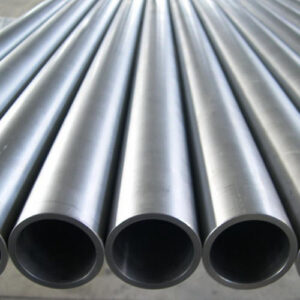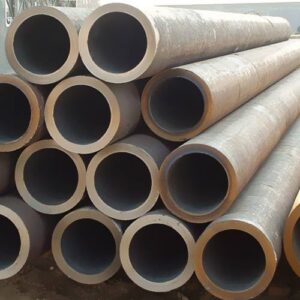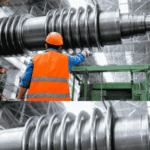Contact : +91-79045 61980 | Email: hydrofitengineers@gmail.com
Hydraulic Seamless Tubes
(DIN 2391 / EN 10305)
Hydraulic seamless tubes are widely used in various industries, helping to improve efficiency and ensure hydraulic system reliability. Ideal for use in high pressure applications these tubes are designed to pass fluids, while remaining resistant and durable hydraulic components.
Hydraulic Seamless Tube is a cold drawn seamless, weld-less steel tube for the demanding industry applications such as for the HPU in hydraulic high-pressure systems, mechanical engineering and for the ship’s crane of versions HMC and HSC. We produce the tubes to DIN 2391 and EN 10305 standards in ST52, S355 up to ST52.4, E355. With that these tubes offer leakage resistance operation with precise dimension and durability just like hydraulic tube fittings. Production of these seamless tubes removes some hard place, which not only improves the pressure resistant capacity, but also takes great tensile strength and cauterization resistance properties.
Key Specifications & Standards (DIN 2391 / EN 10305)
Hydraulic seamless tubes meet worldwide standards like DIN 2391, EN 10305 and provide global material homogenization – precision manufacturing for different industries. The technical parameters as follows:
- Outer Diameter: 4 mm – 190 mm
- Thickness: 0.5 mm To 25 mm
- Length: Maximum 6 meters (cut-to-length service available)
- Material Grades: ST37/E235, ST52/E355
- Finish: NBK (phosphated and normalized), oiled inside and out
- Norm: DIN 2391, EN 10305-1/-4
- Trials: Ultrasonic / Eddy current / Visual examination


Material Grades and Mechanical Properties
Seamless tubes produced under DIN 2391 are often required to be marked with the standard reference (DIN 2391). The way hydraulic fittings under DIN 2353 includes the manufacturer’s mark, specific identification information, and the material grade. These is used for various applications with respect to the length and diameter of the pipe. Applications in size:1/2″ NB 24″ NB Carbon & alloy steel pipes. Class ST37/E235 and ST52/E355 are commonly used. The latter is the best with regard to high-pressure rolls having a high strength at thin walls.
- ST37/E235 : High ductility for low and medium pressure lines.
- ST52/E355: Improves tensile strength, and hardness It is the ideal choice for conveying high pressure fuel.
- Finish: NBK (Normalized) for better formability and tighter mechanical control.
Production Process of Seamless Hydraulic Tubes
The process of producing hydraulic seamless tube under DIN 2391C is controlled by multi-stand, precision -controlled sizing mills to meet the specified dimensional tolerance required and apply work hardening to obtain mechanical properties of the tubes. Here’s a simplified summary of the method:
- Tube Billet Quality Selection : Tube billets are selected based on Mechanical Requirements and Class.
- Heat-treatment or Heating: Billets are heated at a particular temperature to make them more malleable.
- Piercing: The billet charged heated is pierced to hollow tube with rotary or elongation piercing.
- Mandrel mill- or plug mill-process: The process in which the tube is solidified and stretched over a mandrel to achieve its diameter and shape.
- Annealing: Heat treatment which removes internal stress and adds malleability.
- Cold Drawing: the tube passes through drawing dies to achieve a consistent diameter and even surface.
- Partial Annealing: Used when it is necessary to keep the brass formable.
- Last Heat Treatment: Strength based on the required performance levels.
- Non-Destructive Testing: Ultrasonic and eddy current examinations assure defect free quality.
- Surface Treatment & Marking: Phosphating, passivation and standard marking.
Read this article to know more about the manufacturing, heat treatment and testing of hydraulic seamless pipes and you can read about seamless pipes and tubes Mechanical tests as well.
Application of Hydraulic Seamless Tubes
These hydraulic seamless tubes are common in multiple industries because of their ease of use and high pressure tolerances. Typical application sectors include:

Marine

Heavy Engineering

Automotive Industry

Oil & Gas Industry

Construction
No matter what the type of hydraulic seamless tube is used, marine or Construction, goal remains the same to achieve efficient service and extend life. You can read more about use of hydraulic seamless tube in automotive application here.
Advantages of Using Hydraulic Seamless Tubes DIN 2391
• Seamless structure eliminates weld failures and leakage risks.
• Superior mechanical strength under high-pressure conditions.
• Excellent corrosion resistance with NBK finishing.
• Precise dimensional tolerances for consistent assembly.
• Enhanced durability and long operational life.
• Compatible with various hydraulic fittings and ferrules.
FAQ
What is a hydraulic seamless tube?
A hydraulic seamless tube is a weld-free, cold-drawn steel tube designed to handle high-pressure hydraulic fluids efficiently without leakage or deformation.
Which material grade is ideal for high-pressure applications?
ST52/E355 grade is preferred for its higher yield strength and pressure capacity compared to ST37/E235
What standards apply to hydraulic seamless tubes?
DIN 2391 and EN 10305-1/-4 standards define manufacturing precision, testing, and dimensional tolerances.
